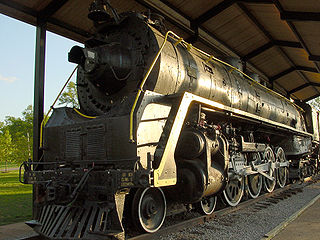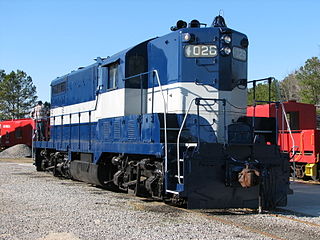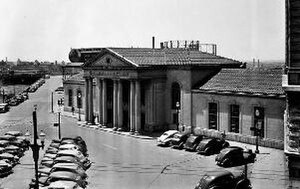
Dixie Highway was a United States auto trail first planned in 1914 to connect the Midwest with the South. It was part of a system and was expanded from an earlier Miami to Montreal highway. The final system is better understood as a network of connected paved roads, rather than one single highway. It was constructed and expanded from 1915 to 1929.

The Atlantic Coast Line Railroad was a United States Class I railroad formed in 1900, though predecessor railroads had used the ACL brand since 1871. In 1967, it merged with long-time rival Seaboard Air Line Railroad to form the Seaboard Coast Line Railroad. Much of the original ACL network has been part of CSX Transportation since 1986.

The Nashville, Chattanooga and St. Louis Railway was a railway company that operated in the U.S. states of Kentucky, Tennessee, Alabama, and Georgia. It began as the Nashville and Chattanooga Railroad, chartered in Nashville on December 11, 1845, built to 5 ft gauge and was the first railway to operate in the state of Tennessee. By the turn of the twentieth century, the NC&StL grew into one of the most important railway systems in the southern United States.

The Louisville and Nashville Railroad, commonly called the L&N, was a Class I railroad that operated freight and passenger services in the southeast United States.

The Georgia Railroad and Banking Company also seen as "GARR", was a historic railroad and banking company that operated in the U.S. state of Georgia. In 1967 it reported 833 million revenue-ton-miles of freight and 3 million passenger-miles; at the end of the year it operated 331 miles (533 km) of road and 510 miles (820 km) of track.

The Chicago and Eastern Illinois Railroad was a Class I railroad that linked Chicago to southern Illinois, St. Louis, and Evansville. Founded in 1877, it grew aggressively and stayed relatively strong throughout the Great Depression and two World Wars before finally being purchased by the Missouri Pacific Railroad and the Louisville and Nashville Railroad (L&N). Missouri Pacific merged with the C&EI corporate entity in 1976, and was later acquired itself by the Union Pacific Railroad.

The Atlanta, Birmingham and Coast Railroad was organized in 1926 to replace the bankrupt Atlanta, Birmingham and Atlantic Railway. The AB&C was controlled by the Atlantic Coast Line Railroad, which owned a majority of the stock. In 1944 it reported 763 million net ton-miles of revenue freight and 33 million passenger-miles; at the end of that year it operated 639 miles of road and 836 miles of track.
The Georgia Rail Passenger Program (GRPP) was a set of plans, as yet unbuilt, for intercity and commuter rail in the U.S. state of Georgia.
The South Wind was a named passenger train equipped and operated jointly by the Pennsylvania Railroad, the Louisville and Nashville Railroad, the Atlantic Coast Line Railroad, and the Florida East Coast Railway. The South Wind began operations in December 1940, providing streamliner service between Chicago, Illinois and Miami, Florida. This was one of three new seven-car, all-coach streamliners operating in coordination every third day along different routes between Chicago and Miami. The other two longest enduring Chicago-Florida trains were the City of Miami and the Dixie Flagler. The South Wind remained in service through the creation of Amtrak in 1971.
The Southeastern Greyhound Lines, a highway-coach carrier, was a Greyhound regional operating company, based in Lexington, Kentucky, USA, from 1931 until 1960, when it became merged with the Atlantic Greyhound Lines, a neighboring operating company, thereby forming the Southern Division of The Greyhound Corporation, called also the Southern Greyhound Lines.

The Dixie Flagler was a streamlined passenger train operated by the Florida East Coast Railway (FEC) between Chicago, Illinois and Miami, Florida. It began in 1939 as the Henry M. Flagler, a regional service between Miami and Jacksonville, Florida; the FEC renamed it and extended it to Chicago a year later. It was one of the few Chicago to Florida trains that passed through Atlanta. As an overnight streamliner it was part of the every-third-day pool shared by the City of Miami and South Wind. It was renamed Dixieland in 1954 and discontinued altogether in 1957.

The Western and Atlantic Depot is a historic Western and Atlantic Railroad train depot in Dalton, Georgia. It was built in 1852 in the Greek Revival style. The building is the oldest surviving commercial structure in Dalton and is a "fine example" of depot architecture in Georgia in the mid-1800s. It served as both a freight and passenger station.

The Dixie Flyer was a premier named passenger train that operated from 1892 to 1965 via the "Dixie Route" from Chicago and St. Louis via Evansville, Nashville, and Atlanta to Florida. However, the train continued until 1969 as an Atlanta to Florida operation, run solely by the Atlantic Coast Line Railroad and its successor, the Seaboard Coast Line. The Flyer's route varied in early years, but by about 1920 was set as follows:

Louisville and Nashville Railroad Station, also known as L & N Station, was a historic train station located in downtown Evansville, Indiana. It was built in 1902 for the Louisville and Nashville Railroad, and was a Richardsonian Romanesque style rock-faced limestone building. It consisted of a three-story central block with two-story flanking wings, and a one-story baggage wing. It had projecting gabled pavilions and a slate hipped roof.
Chattanooga Union Station, more commonly known as the Union Depot in Chattanooga, constructed between 1857-1859, served as a train car shed in Chattanooga, Tennessee. Located at Broad and Ninth Streets, the station was one of two major railroad terminals in the city, the other being the Southern Railway's Terminal Station.
The Georgian was a long-distance passenger train operated by the Louisville and Nashville Railroad in conjunction with the Chicago and Eastern Illinois Railroad. It operated between St. Louis Union Station and Atlanta's Union Station with a section operated by the C&EI from Evansville to Chicago's Dearborn Station. From Nashville to Atlanta it operated over the tracks of the Nashville, Chattanooga and St. Louis Railway. The introduction of this train made the C&EI's Chicago-Evansville Whippoorwill train superfluous.
The Flamingo was a passenger night train operated by the Louisville and Nashville Railroad.
The Southland was a night train between Chicago, Illinois and different points in western and eastern Florida from 1915 to 1957. In the early years it was called the New Southland. It was distinctive among Midwest to Florida trains as its western branch was the only all-season mid-20th-century long-distance train passing from Georgia to Florida bypassing the usual passenger train hub of Jacksonville Union Station. The main operator was the Louisville and Nashville Railroad, and pooling partners were the Pennsylvania Railroad, the Atlantic Coast Line Railroad and to lesser extent, the Wabash Railroad and the Florida East Coast Railway. For southeast bound -but not northwest bound- trips to Norfolk, Virginia, some coaches in 1946 diverged at Cincinnati along a Norfolk and Western Railway route. Northwest bound, travelers could switch trains at Cincinnati for heading towards Chicago.
The Marietta depot is a former freight and passenger stop in Marietta, Georgia. It was originally built in 1864 for the Western and Atlantic Railroad, a railroad between Chattanooga, Tennessee and Atlanta, Georgia. That railroad was absorbed by the Nashville, Chattanooga and St. Louis Railway. In turn, the latter railroad was merged into the Louisville and Nashville Railroad in 1957.











